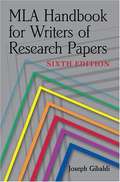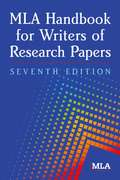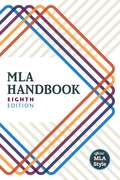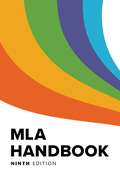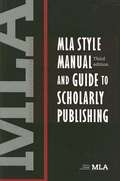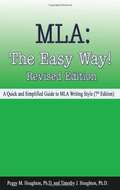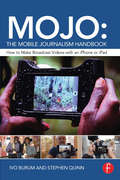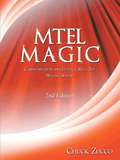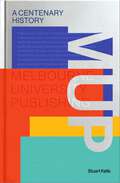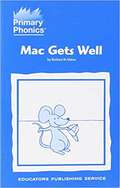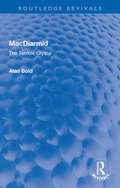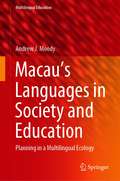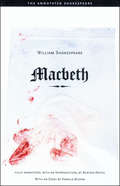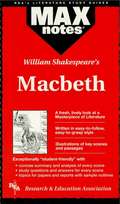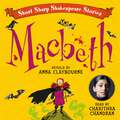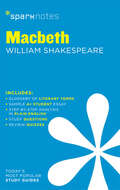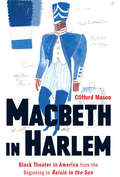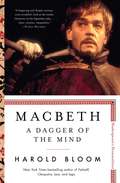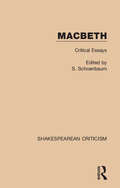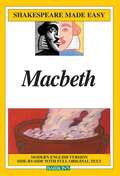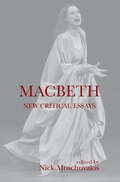- Table View
- List View
MLA Handbook for Writers of Research Papers (6th Edition)
by Joseph GibaldiThe Modern Language Association publishes two books on its documentation style: the MLA Handbook for Writers of Research Papers (for high school and undergraduate students) and the MLA Style Manual and Guide to Scholarly Publishing (for graduate students, scholars, and professional writers). These volumes provide the most accurate and complete instructions on MLA style. The publisher of this book donated a digital copy to Bookshare.org. Join us in thanking The Modern Language Association for providing this accessible digital book to this community.
MLA Handbook for Writers of Research Papers (7th edition)
by Joseph GibaldiThe seventh edition of the MLA Handbook is a comprehensive, up-to-date guide to research and writing in the online environment. It provides an authoritative update of MLA documentation style.
MLA Handbook, 8th Edition
by The Modern Language Association of AmericaThe Modern Language Association, the authority on research and writing, takes a fresh look at documenting sources in the eighth edition of the MLA Handbook. Works are published today in a dizzying range of formats. A book, for example, may be read in print, online, or as an e-book--or perhaps listened to in an audio version. On the Web, modes of publication are regularly invented, combined, and modified. Previous editions of the MLA Handbook provided separate instructions for each format, and additional instructions were required for new formats. In this groundbreaking new edition of its best-selling handbook, the MLA recommends instead one universal set of guidelines, which writers can apply to any type of source. Shorter and redesigned for easy use, the eighth edition of the MLA Handbook guides writers through the principles behind evaluating sources for their research. It then shows them how to cite sources in their writing and create useful entries for the works-cited list. More than just a new edition, this is a new MLA style.
MLA Handbook, Ninth edition
by The Modern Language Association of AmericaRelied on by generations of writers, the MLA Handbook is published by the Modern Language Association and is the only official, authorized book on MLA style. The new, ninth edition builds on the MLA's unique approach to documenting sources using a template of core elements--facts, common to most sources, like author, title, and publication date--that allows writers to cite any type of work, from books, e-books, and journal articles in databases to song lyrics, online images, social media posts, dissertations, and more. With this focus on source evaluation as the cornerstone of citation, MLA style promotes the skills of information and digital literacy so crucial today. The many new and updated chapters make this edition the comprehensive, go-to resource for writers of research papers, and anyone citing sources, from business writers, technical writers, and freelance writers and editors to student writers and the teachers and librarians working with them. Intended for a variety of classroom contexts--middle school, high school, and college courses in composition, communication, literature, language arts, film, media studies, digital humanities, and related fields--the ninth edition of the MLA Handbook offers New chapters on grammar, punctuation, capitalization, spelling, numbers, italics, abbreviations, and principles of inclusive language Guidelines on setting up research papers in MLA format with updated advice on headings, lists, and title pages for group projects Revised, comprehensive, step-by-step instructions for creating a list of works cited in MLA format that are easier to learn and use than ever before A new appendix with hundreds of example works-cited-list entries by publication format, including websites, YouTube videos, interviews, and more Detailed examples of how to find publication information for a variety of sources Newly revised explanations of in-text citations, including comprehensive advice on how to cite multiple authors of a single work Detailed guidance on footnotes and endnotes Instructions on quoting, paraphrasing, summarizing, and avoiding plagiarism A sample essay in MLA format Annotated bibliography examples Numbered sections throughout for quick navigation Advanced tips for professional writers and scholars
MLA Style Manual and Guide to Scholarly Publishing (3rd Edition)
by The Modern Language Association of AmericaA complete, up-to-date guide for writing scholarly texts, documenting research sources, submitting manuscripts to publishers, and dealing with legal issues surrounding publication.
MLA The Easy Way
by Peggy M. Houghton Timothy J. Houghton Michele M. PrattMLA The Easy Way 8th Edition
MLA: The Easy Way! Revised Edition 2009
by Peggy M. Houghton Timothy J. HoughtonMLA: The Easy Way! presents the basics of MLA style in a clear, concise, accurate, and easy-to-navigate package.
MOJO: How to Make Broadcast Videos with an iPhone or iPad
by Stephen Quinn Ivo BurumMOJO: The Mobile Journalism Handbook is the first book devoted specifically to training citizens, journalism students and media professionals to produce professional-quality videos with only a mobile device. As journalism becomes increasingly competitive, students and emerging professionals need a broader skillset to make themselves more employable, whether as mainstream or entrepreneurial journalists. This book by Dr. Ivo Burum and Dr. Stephen Quinn, world experts in mobile journalism, provides comprehensive coverage of all the skills and practices needed to be a mobile journalist. Key features: Burum and Quinn underline the importance of story and storytelling, the crucial context journalists always need to keep in mind. Other books and tutorials merely offer step-by-step guidance to mobile technology and apps. The book synthesizes the knowledge and more than 70 years of combined expertise of two of the world’s leading mobile journalism practitioners, offering sage advice and tips from people who have trained mojos in more than 20 countries. Companion Website: How-to videos on the companion website offer powerful ways for learners to absorb the content easily, walking them through the key mojo components of research, shooting, scripting, voice-over, editing and post-production. www.routledge.com/cw/burum Ivo Burum is an award-winning writer, director and television executive producer. He has more than 30 years’ experience working across genres including frontline international current affairs. A pioneer in UGS creation, Dr. Burum lectures in multimedia journalism. This is his second book about mojo. He runs Burum Media, a mojo and web TV consultancy that provides training for journalists, educators and remote communities internationally. Stephen Quinn was a journalist for 20 years before he became a university professor in 1996. Dr. Quinn taught journalism in five countries until he returned to journalism in 2011 in Hong Kong. His UK-based company MOJO Media Insights trains mobile journalists around the world. This is his twenty-first print book. He has also produced 5 iBooks. He co-writes a weekly column syndicated to seven countries.
MTEL Magic: Writing Subtest
by Chuck ZuccoThe name of this book is a misnomer. There really is no magical solution to taking this or any other test. What makes this book different is that it presents a simple formula for passing-skills + strategies + practice = success.
MUP: A Centenary History
by Stuart KellsAustralia's oldest university press is also one of our best known and most trusted publishers. Founded in 1921 as a bookshop for students at the University of Melbourne, Melbourne University Press was soon publishing important works that contained the best of national scholarship. Landmark MUP books and series include The Australian Dictionary of Biography, Manning Clark's History of Australia, The Encyclopaedia of New Guinea and the journal Meanjin. These and other MUP publications helped shape how Australians perceived themselves, and how they talked about literature, politics, race, the Pacific, the world wars and public policy. From its inception, MUP grappled with hard questions. How should a university press be governed? To what extent should such a press be concerned with political, polemical and radical works? And can a university press be financially self-sustaining if it focuses on books that commercial publishers overlook? The respective leaders of MUP answered these questions in ways that regularly led the press into controversy. Using a century of MUP publications and archives, Stuart Kells has written a rich and fascinating history of an invaluable Australian institution-one that is widely seen as public property, and whose ups and downs have always been news.
MacDiarmid: The Terrible Crystal (Routledge Revivals)
by Alan BoldFirst published in 1983, Hugh MacDiarmid: The Terrible Crystal is a detailed introduction to the poetry of Hugh MacDiarmid. Hugh MacDiarmid’s poetry shows a persistent search for a consistent intellectual vision that reveals, in all its facets, the source of creativity recognised by the poet as ‘the terrible crystal’. This introduction to his poetry shows that MacDiarmid’s great achievement was a poetry of evolutionary idealism, that draws attention to itself by a series of culture shocks. It places MacDiarmid as a nationalist poet in an international context: a man whose unique concept of creative unity enabled him to combine the Scottish tradition with the linguistic experimentation of Joyce and Pound. Hugh MacDiarmid: The Terrible Crystal is ideal for those with an interest in the poetry of Hugh MacDiarmid, Scottish poetry, and poetry and criticism more broadly.
MacMillan/McGraw Hill Treasures [Grade 4]
by Jana Echevarria Donald R. Bear Janice A. Dole Jan E. Hasbrouck Scott G. Paris Timothy Shanahan Josefina V. TinajeroNIMAC-sourced textbook
Macau’s Languages in Society and Education: Planning in a Multilingual Ecology (Multilingual Education #39)
by Andrew J. MoodyThis book examines the role of English within education and society in the quickly changing city of Macau. Macau’s multilingual language ecology offers the unique opportunity to examine language planning and policy issues within a small speech community. The languages within the ecology include several Chinese varieties, such as Cantonese, Putonghua and Hokkien, European languages like Portuguese and English, and a number of Asian languages that include, among others, Burmese, Filipino languages, Japanese, Timorese, etc. As the smallest city in South China's Pearl River Delta, Macau has sought to maintain cultural and linguistic independence from its larger neighbours, and independence has been built upon an historic commitment to multilingualism and cultural plurality. As economic development and globalisation offer new opportunities to a growing middle class, the sociolinguistics of a small society constrain and influence the language policies that the territory seeks to implement. Macau's multilingual and pluralistic response to language needs within the territory echoes historical responses to similar challenges and suggests that small communities function sociolinguistically in ways that differ from larger communities.
Macbeth
by William ShakespearePerhaps no other Shakespearean drama so engulfs its readers in the ruinous journey of surrender to evil as does Macbeth. A timeless tragedy about the nature of ambition, conscience, and the human heart, the play holds a profound grip on the Western imagination. [This text is listed as an example that meets Common Core Standards in English language arts in grades 9-10 at http://www.corestandards.org.]
Macbeth (MAXNotes Literature Guides)
by Rebecca SheinbergREA's MAXnotes for William Shakespeare's Macbeth The MAXnotes offers a comprehensive summary and analysis of Macbeth and a biography of William Shakespeare. Places the events of the play in historical context and discusses each act in detail. Includes study questions and answers along with topics for papers and sample outlines.
Macbeth (Short, Sharp Shakespeare Stories #25)
by Anna ClaybourneIs this a dagger which I see before me...?A power-hungry general, his crazed wife, three interfering witches and some terrifying ghosts... Listen on, through murder and mayhem, to discover the gripping story of Macbeth, one of Shakespeare's most famous tragedies.As well as the story, this audiobook contains information about the background to Macbeth, its major themes, language, and Shakespeare's life during the time he was writing the play. Witches and witchcraft in 16th century England are also examined, to give the context in which the play was written. The Short, Sharp Shakespeare series consists of six books that retell Shakespeare's most famous plays in modern English. Fun sound effects and atmospheric music accompany each narration, making them a great introduction to "the Bard" for children.(P) 2023 Hodder & Stoughton Limited
Macbeth SparkNotes Literature Guide (SparkNotes Literature Guide Series #43)
by SparkNotesMacbeth SparkNotes Literature Guide by William Shakespeare Making the reading experience fun! When a paper is due, and dreaded exams loom, here's the lit-crit help students need to succeed! SparkNotes Literature Guides make studying smarter, better, and faster. They provide chapter-by-chapter analysis; explanations of key themes, motifs, and symbols; a review quiz; and essay topics. Lively and accessible, SparkNotes is perfect for late-night studying and paper writing. Includes:An A+ Essay—an actual literary essay written about the Spark-ed book—to show students how a paper should be written.16 pages devoted to writing a literary essay including: a glossary of literary termsStep-by-step tutoring on how to write a literary essayA feature on how not to plagiarize
Macbeth in Harlem: Black Theater in America from the Beginning to Raisin in the Sun
by Clifford MasonIn 1936 Orson Welles directed a celebrated all-black production of Macbeth that was hailed as a breakthrough for African Americans in the theater. For over a century, black performers had fought for the right to perform on the American stage, going all the way back to an 1820s Shakespearean troupe that performed Richard III, Othello, and Macbeth, without relying on white patronage. "Macbeth" in Harlem tells the story of these actors and their fellow black theatrical artists, from the early nineteenth century to the dawn of the civil rights era. For the first time we see how African American performers fought to carve out a space for authentic black voices onstage, at a time when blockbuster plays like Uncle Tom’s Cabin and The Octoroon trafficked in cheap stereotypes. Though the Harlem Renaissance brought an influx of talented black writers and directors to the forefront of the American stage, they still struggled to gain recognition from an indifferent critical press. Above all, "Macbeth" in Harlem is a testament to black artistry thriving in the face of adversity. It chronicles how even as the endemic racism in American society and its theatrical establishment forced black performers to abase themselves for white audiences’ amusement, African Americans overcame those obstacles to enrich the nation’s theater in countless ways.
Macbeth, and King Richard The Third: An Essay, In Answer to Remarks on Some of The Characters of Shakespeare (Routledge Revivals)
by J.P. KembleJohn Philip Kemble was an ambitious and successful stage actor in London, perhaps most well-known for his turn as Shakespeare’s Macbeth. Kemble passionately disagreed with the posthumous work of Thomas Watley, Remarks on Some of the Characters of Shakespeare (1785), particularly Watley’s representations of some of Shakespeare’s greatest villains, Richard III and Macbeth. This title, first published in 1786 (this reprint of the second edition first published in 1970), presents Kemble’s nuanced criticisms of the characters leaving the impression that the villainies of Macbeth and Richard III are indeed similar. A historically important literary reaction, this title will be of interest to students of English literature and literary criticism.
Macbeth: A Dagger of the Mind (Shakespeare's Personalities #5)
by Harold BloomFrom the greatest Shakespeare scholar of our time, comes a portrait of Macbeth, one of William Shakespeare’s most complex and compelling anti-heroes—the final volume in a series of five short books about the great playwright’s most significant personalities: Falstaff, Cleopatra, Lear, Iago, Macbeth.From the ambitious and mad titular character to his devilish wife Lady Macbeth to the moral and noble Banquo to the mysterious Three Witches, Macbeth is one of William Shakespeare’s more brilliantly populated plays and remains among the most widely read, performed in innovative productions set in a vast array of times and locations, from Nazi Germany to Revolutionary Cuba. Macbeth is a distinguished warrior hero, who over the course of the play, transforms into a brutal, murderous villain and pays an extraordinary price for committing an evil act. A man consumed with ambition and self-doubt, Macbeth is one of Shakespeare’s most vital meditations on the dangerous corners of the human imagination. Award-winning writer and beloved professor Harold Bloom investigates Macbeth’s interiority and unthinkable actions with razor-sharp insight, agility, and compassion. He also explores his own personal relationship to the character: Just as we encounter one Anna Karenina or Jay Gatsby when we are seventeen and another when we are forty, Bloom writes about his shifting understanding—over the course of his own lifetime—of this endlessly compelling figure, so that the book also becomes an extraordinarily moving argument for literature as a path to and a measure of our humanity. Bloom is mesmerizing in the classroom, wrestling with the often tragic choices Shakespeare’s characters make. He delivers that kind of exhilarating intimacy and clarity in Macbeth, the final book in an essential series.
Macbeth: Critical Essays (Shakespearean Criticism)
by S. SchoenbaumOriginally published in 1991. Collecting together commentary and critique on ‘the Scottish play’, this book showcases varied discussions of the text and the theatrical productions. From Samuel Johnson’s brief 1765 comment to the editor’s own piece on the Porter’s scene, the texts included here are popular important accounts of thoughts and scholarship on the play over the years. Some pieces address the most famous early Lady Macbeth – Mrs Siddons, while others look at a theme or specific issue such as Lady Macbeth’s children. This is a great sample of the voluminous body of work looking at the tragedy, considering its images, symbols, meanings and its challenges for the stage.
Macbeth: Modern English Version Side-by-side With Full Original Text (Shakespeare Made Easy)
by William ShakespeareHere are the books that help teach Shakespeare plays without the teacher constantly needing to explain and define Elizabethan terms, slang, and other ways of expression that are different from our own. Each play is presented with Shakespeare's original lines on each left-hand page, and a modern, easy-to-understand "translation" on the facing right-hand page. All dramas are complete, with every original Shakespearian line, and a full-length modern rendition of the text. Helpful background information that puts each play in its historical perspective. Discussion questions that teachers can use to spark student class participation, and which students can use as springboards for their own themes and term papers. Fact quizzes, sample examinations, and other features that improve student comprehension of what each play is about.
Macbeth: New Critical Essays (Shakespeare Criticism)
by Nick MoschovakisThis volume offers a wealth of critical analysis, supported with ample historical and bibliographical information about one of Shakespeare’s most enduringly popular and globally influential plays. Its eighteen new chapters represent a broad spectrum of current scholarly and interpretive approaches, from historicist criticism to performance theory to cultural studies. A substantial section addresses early modern themes, with attention to the protagonists and the discourses of politics, class, gender, the emotions, and the economy, along with discussions of significant ‘minor’ characters and less commonly examined textual passages. Further chapters scrutinize Macbeth’s performance, adaptation and transformation across several media—stage, film, text, and hypertext—in cultural settings ranging from early nineteenth-century England to late twentieth-century China. The editor’s extensive introduction surveys critical, theatrical, and cinematic interpretations from the late seventeenth century to the beginning of the twenty-first, while advancing a synthetic argument to explain the shifting relationship between two conflicting strains in the tragedy’s reception. Written to a level that will be both accessible to advanced undergraduates and, at the same time, useful to post-graduates and specialists in the field, this book will greatly enhance any study of Macbeth. Contributors: Rebecca Lemon, Jonathan Baldo, Rebecca Ann Bach, Julie Barmazel, Abraham Stoll, Lois Feuer, Stephen Deng, Lisa Tomaszewski, Lynne Bruckner, Michael David Fox, James Wells, Laura Engel, Stephen Buhler, Bi-qi Beatrice Lei, Kim Fedderson and J. Michael Richardson, Bruno Lessard, Pamela Mason.
